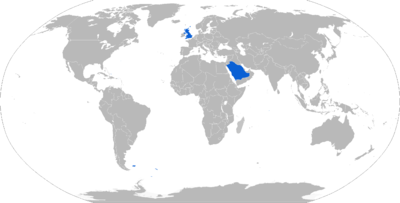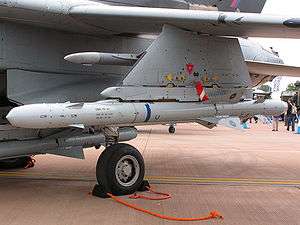ALARM
| ALARM[1] | |
|---|---|
|
ALARM under the wing of a RAF Tornado GR4 | |
| Type | Air-to-surface anti-radar missile |
| Service history | |
| In service | 1990 |
| Used by | See operators |
| Wars | Gulf War, Kosovo War, Iraq War, Libyan Civil War, Yemeni Civil War (2015-present), Saudi Arabian-led intervention in Yemen |
| Production history | |
| Designer | BAe Dynamics |
| Designed | 1982 |
| Manufacturer |
BAe Dynamics (1982–1999) MBDA (UK) Ltd (since 1999) |
| Unit cost | undisclosed |
| Produced | 1986–present |
| Specifications | |
| Weight | 268 kilograms (591 lb) |
| Length | 4.24 metres (13.9 ft) |
| Diameter | 230 millimetres (9.1 in) |
| Warhead | Proximity fused high-explosive |
Detonation mechanism | Laser Proximity |
|
| |
| Engine | Bayern Chemie two stage solid-fuel rocket motors |
| Wingspan | 0.73 metres (2.4 ft) |
| Propellant | solid-propellant |
Operational range | 93 kilometres (58 mi) |
| Speed | 2,455 kilometres per hour (1,525 mph) (supersonic) |
Guidance system | Pre-programmed/passive radar seeker |
Launch platform | Tornado GR.4, Tornado F3, J22 Orao |
ALARM (Air Launched Anti-Radiation Missile) is a British anti-radiation missile designed primarily to destroy enemy radars for the purpose of Suppression of Enemy Air Defense (SEAD). It was used by the RAF and is still used by the Royal Saudi Air Force,.[2] The weapon was retired by the UK at the end of 2013.[3]
History
The Ministry of Defence received bids for a new anti-radiation missile in late 1982; British Aerospace Dynamics offered ALARM while Texas Instruments teamed with Lucas Aerospace offered its HARM missile.[4] Defence Secretary Michael Heseltine announced the selection of ALARM on 29 July 1983. The initial order was 750 missiles for the RAF.[5] The selection process was controversial; the battle between the contractors was bitter, the Ministry of Defence favoured ALARM to retain UK industrial capabilities while the Treasury favoured the cheaper and proven HARM.[4][6]
In early 1986, BAe recognised that Royal Ordnance was having difficulties delivering the missile's motor, named Nuthatch, and began to consider alternatives. Royal Ordnance's solution to the required burn-loiter-burn characteristic of the engine was complex.[7] In July 1987, BAe, by then the owner of Royal Ordnance, replaced the Nuthatch motor with a lower risk motor designed by Bayern-Chemie.[8] BAe's GB£200 million contract for the missile was renegotiated with the price increased to GB£400 million and delivery pushed back from 1988 to 1990.[9]
The ALARM missile was officially retired by the UK at the end of 2013,[3] but continued to be used by the Saudis.[10]
Features
ALARM is a fire-and-forget system, with an added loiter capability. In loiter mode, ALARM will, when launched, climb to an altitude of 13 km. If the target radar shuts down, the missile will deploy a parachute and descend slowly until the radar lights up. The missile will then fire a secondary motor to attack the target.[11]
Combat use
ALARM has been used in the following conflicts:
- 1991 Gulf War (Operation Granby), during which 121 missiles were used.[12]
- Kosovo War (Operation Allied Force), during which 6 missiles were used.[13]
- 2003 invasion of Iraq (Operation Telic), during which 47 missiles were used.[14][15]
- 2011 Libya (Operation Ellamy).[14]
- 2015 Yemen.[16]
Operators

Current operators
Former operators
Specifications
- Primary Function: Suppression of Enemy Air Defence
- Contractor: MBDA
- Power Plant: Bayern Chemie two stage solid propellant rocket motors
- Length: 4.24 m
- Diameter: 23 cm
- Wing Span: 73 cm
- Launch Weight: 268 kg
- Speed: 2455 km/h (supersonic)
- Warhead: Proximity fused high-explosive
- Range: 93 km
- Fuse: Laser Proximity
- Guidance system: Pre-programmed/passive radar seeker
- Unit Cost: undisclosed
- Date Deployed: 1990
- User: UK (RAF)
- Tornado GR.4
- Tornado F3: fitted in time for 2003 Gulf War, receiving designation Tornado EF3
- Weapon has been "fit checked" on other RAF aircraft, such as the Jaguar. Due to its relatively large weight it is not suited to the entire RAF fleet.
- Also was expected to be usable on the Eurofighter Typhoon, but this requirement was deleted.[17]
References
- ↑ "ALARM, fas.org".
- ↑ "Saudis review F.3 air-defence role". Flight International. Reed Business Publishing. 1991-12-25.
- 1 2 Scott, Richard (21 January 2014). "UK retires ALARM missile". IHS Jane's 360. Archived from the original on 1 February 2014. Retrieved 15 February 2015.
- 1 2 Bloom, Bridget (1983-05-16). "Thatcher to resolve anti-radar missile row". Financial Times.
- ↑ "British Select Alarm Missile Over HARM". Aviation Week & Space Technology. McGraw-Hill. 1983-07-08.
- ↑ Bloom, Bridget (1983-07-30). "Missile manufacturers bid for UK navy deal". Financial Times.
- ↑ Buchan, David (20 July 1987). "BAe Cancels Missile Deal With Royal Ordnance". Financial Times.
- ↑ "British Aerospace Delays Missile Program". Aviation Week & Space Technology. McGraw-Hill. 21 September 1987.
- ↑ Evans, Michael (18 March 1988). "Missile bill for RAF up £150 million". The Times. Times Newspapers.
- ↑ UK-Supplied Precision Weapons Prove Popular in Saudi-Led Yemen Campaign - Defensenews.com, 17 October 2016
- ↑ http://www.flightglobal.com/pdfarchive/view/1987/1987%20-%201575.html
- ↑ "RAF Tornados begin Yugoslavia operations from Corsican base". Aerospace Daily & Defense Report. The McGraw-Hill Companies. 1999-06-03.
- ↑ Cordesman, Anthony H (2000). The Lessons and Non-Lessons of the Air and Missile Campaign in Kosovo. p. 339.
- 1 2 "RAF Weapons: Long-Range-Air-to-Surface Weapons". The Royal Air Force. Retrieved 15 February 2015.
- ↑ "Royal Air Force Dropped More Than 400 Enhanced Paveway Bombs During OIF". Defense Daily. 8 July 2003. Retrieved 9 August 2015 – via HighBeam Research. (Subscription required (help)).
- ↑ "Yemen: Armed Conflict:Written question - 46338". UK Parliament. Retrieved 2016-10-17.
- ↑ Major Projects Report 2008, page 149(155). UK Ministry of Defence, 2008.
External links
| Wikimedia Commons has media related to ALARM. |
- RAF: ALARM description
- Bayern-Chemie—Development and production of a rocket motor used by ALARM. More than 1,200 produced
- Matra-BAe Dynamics ALARM at Eurofighter Typhoon—a brief history of ALARM
- RAF Weapons at armedforces.co.uk
